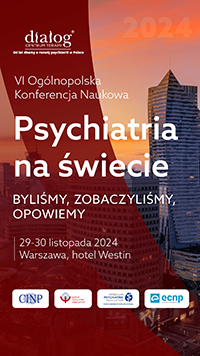Assessment of the occurrence of indirect self-destructiveness in people diagnosed with depressive and anxiety disorders
Anna Sławińska1, Agata Orzechowska1, Antoni Florkowski2
 Affiliacja i adres do korespondencji
Affiliacja i adres do korespondencjiAim: Self-destructiveness involves behaviours whose likely negative effect is mediated by additional factors, and the relationship between behaviour and damage is perceived as probable. The main objective of the research is to evaluate the behaviour of indirect self-destructiveness in patients with symptoms of anxiety and/or depression (compared to the persons without mental disorders-control group). Material and method: Clinical group included 40 patients of the Department of Adult Psychiatry at the Medical University of Lodz – people reporting symptoms of anxiety and/or depressed mood. The control group consisted of people without mental disorders. Polish version of Chronic Self-Destructiveness Scale (CS-DS) adapted by Suchanska and Hospital Anxiety and Depression Scale – Modified (HADS-M) by Snaith and Zigmond were used. The survey aimed at collecting sociodemographic data. Results: Differences were noticed between the clinical and control group in the following indirect autodestructive behaviours: Poor Health Maintenance, Lack of Planfulness, Personal and Social Neglects, Helplessness and Passiveness. Behaviours in all of those areas were more frequent in the clinical group. There were no significant differences noticed between groups in terms of: Transgression and Risk, alcohol use and smoking. Conclusions: Anxiety and depressive disorders promotes occurring of indirect self destructive behaviours.















